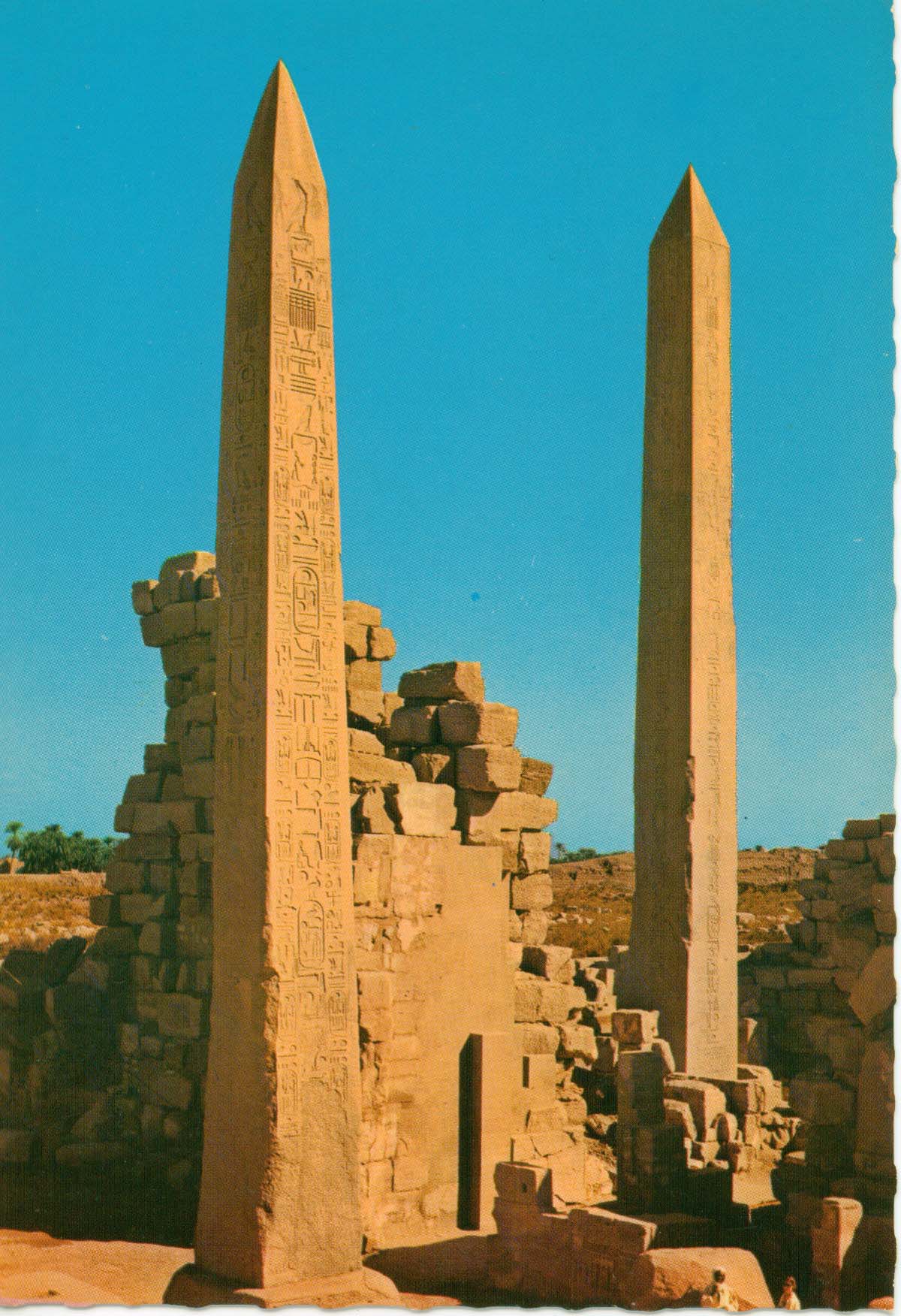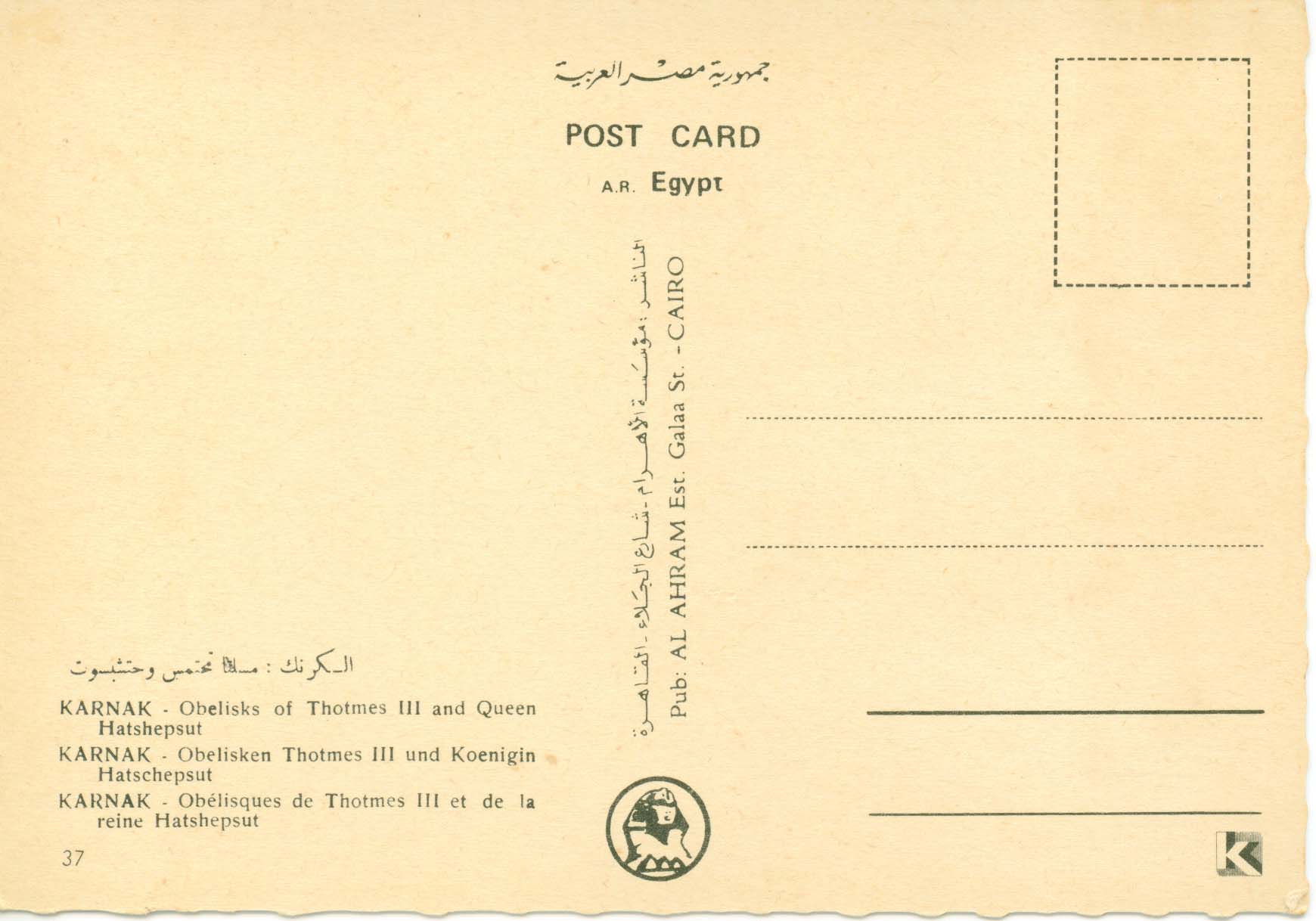Wikipedia. The obelisk gallery looks similar to the image on the postcard.
-----
Thutmose III - From Wikipedia, the free encyclopedia
--
Thutmose III (sometimes read as Thutmosis or Tuthmosis III and meaning Son of Thoth) was the sixth Pharaoh of the Eighteenth Dynasty. During the first twenty-two years of Thutmose's reign he was co-regent with his aunt, Hatshepsut, who was named the pharaoh. While she is shown first on surviving monuments, both were assigned the usual royal names and insignia and neither is given any obvious seniority over the other. He served as the head of her armies.
After her death and his later rise to being the pharaoh of the kingdom, he created the largest empire Egypt had ever seen; no fewer than seventeen campaigns were conducted, and he conquered from Niy in north Syria to the fourth waterfall of the Nile in Nubia. Officially, Thutmose III ruled Egypt for almost fifty-four years, and his reign is usually dated from April 24, 1479 BC to March 11, 1425 BC; however, this includes the twenty-two years he was co-regent to Hatshepsut--his stepmother and aunt. During the last two years of his reign he became a coregent again, with his son, Amenhotep II, who would succeed him. When he died he was buried in the Valley of the Kings as were the rest of the kings from this period in Egypt.
Karnak
Thutmose dedicated far more attention to Karnak than any other site. In the Iput-isut, the temple proper in the center, he rebuilt the hypostyle hall of his grandfather Thutmose I, dismantled the red chapel of Hatshepsut, built Pylon VI, a shrine for the bark of Amun in its place, and built an antechamber in front of it, the ceiling of which was supported by his heraldic pillars. He built a temenos wall around the central chapel containing smaller chapels, along with workshops and storerooms. East of the main sanctuary, he built a jubilee hall in which to celebrate his Sed festival. The main hall was built in basilica style, with rows of pillars supporting the ceiling on each side of the aisle. The central two rows were higher than the others to create windows where the ceiling was split. Two of the smaller rooms in this temple contained the reliefs of the survey of the plants and animals of Canaan which he took in his third campaign.
East of the Iput-Isut, he erected another temple to Aten where he was depicted as being supported by Amun. It was inside this temple that Thutmose planned on erecting his tekhen waty, or "unique obelisk." The tekhen waty was designed to stand alone, instead as part of a pair, and is the tallest obelisk ever successfully cut. It was not, however, erected until Thutmose IV raised it, thirty five years later. It was later moved to Rome and is known as the Lateran Obelisk.
Another Christian Roman Emperor Theodosius I re-erected another obelisk from the Temple of Karnak in the Hippodrome of Constantinople, in 390 CE. Thus, two obelisks of Tuthmosis III's Karnak temple stand in Papal Rome and in Caesaropapist Constantinople, the two main historical capitals of the Roman Empire.
Thutmose also undertook building projects to the south of the main temple, between the sanctuary of Amun and the temple of Mut. Immediately to the south of the main temple, he built the seventh pylon on the north-south road which entered the temple between the fourth and fifth pylons. It was built for use during his jubilee, and was covered with scenes of defeated enemies. He set royal colossi on both sides of the pylon, and put two more obelisks on the south face in front of the gateway. The eastern one's base remains in place, but the western one was transported to hippodrome in Constantinople. farther south, alone the road, he put up pylon VIII which Hatshepsut had begun. East of the road, he dug a sacred lake of 250 by 400 feet, and then placed another alabaster bark shrine near it.
-----
Hatshepsut - From Wikipedia, the free encyclopedia
--
Hatshepsut (or Hatchepsut, pronounced /hæt'??ps?t/), meaning Foremost of Noble Ladies, (1508 BC - 1458 BC) was the fifth pharaoh of the eighteenth dynasty of Ancient Egypt. She is generally regarded by Egyptologists as one of the most successful pharaohs, reigning longer than any other woman of an indigenous Egyptian dynasty.
Although poor records of her reign are documented in diverse ancient sources, Hatshepsut was described by early modern scholars as only having served as a co-regent from about 1479 to 1458 BC, during years seven to twenty-one of the reign previously identified as that of Thutmose III. Today it is generally recognized that Hatshepsut assumed the position of pharaoh and the length of her reign usually is given as twenty-two years, since she was assigned a reign of twenty-one years and nine months by the third-century B.C. historian, Manetho, who had access to many records that now are lost. Her death is known to have occurred in 1458 BC, which implies that she became pharaoh circa 1479 BC.
Following the tradition of most pharaohs, Hatshepsut had monuments constructed at the Temple of Karnak. She also restored the original Precinct of Mut, the ancient great goddess of Egypt, at Karnak that had been ravaged by the foreign rulers during the Hyksos occupation. She had twin obelisks, at the time the tallest in the world, erected at the entrance to the temple. One still stands, as the tallest surviving ancient obelisk on Earth; the other has broken in two and toppled.
----------

--
Karnak - Obelisks of Thotmes III and Queen Hatshepsut
